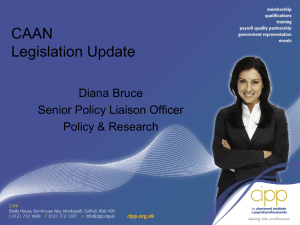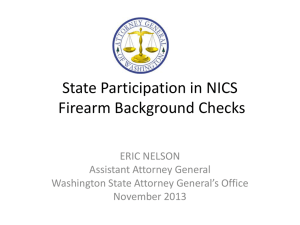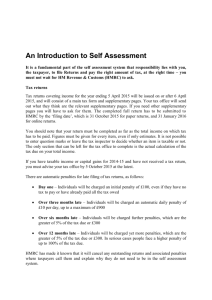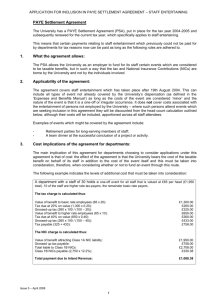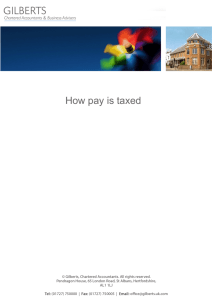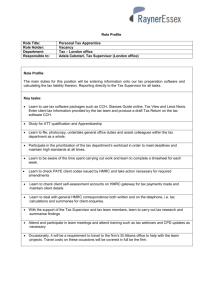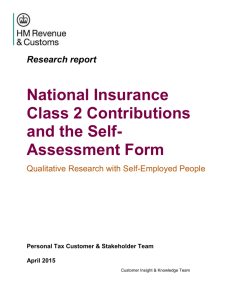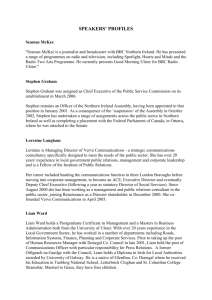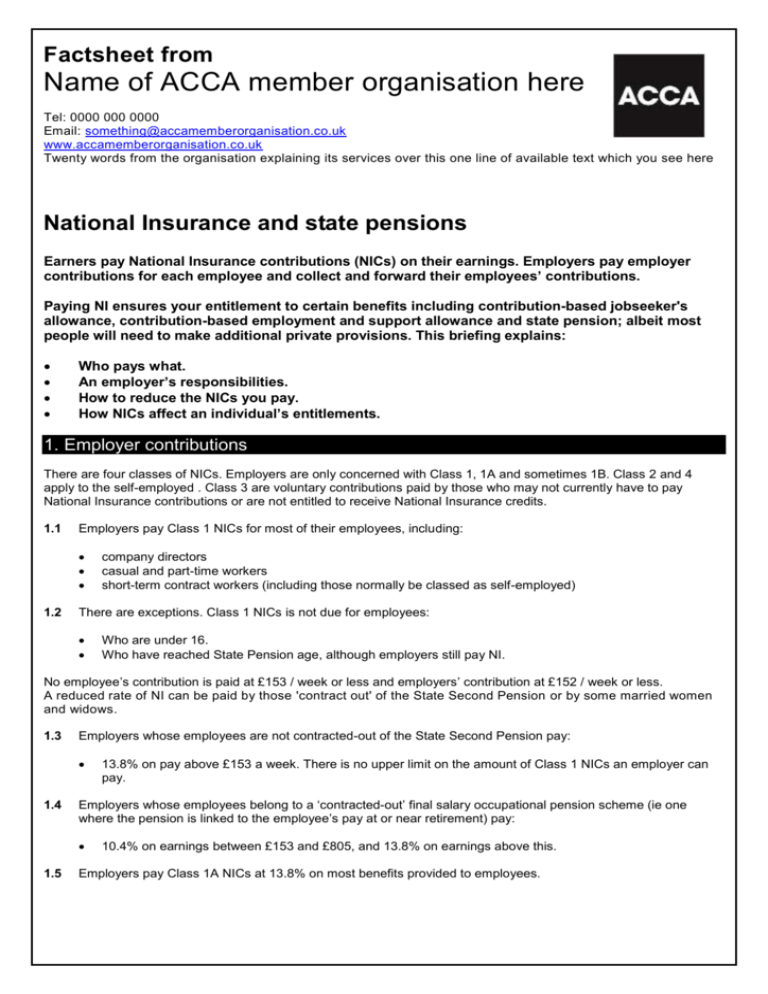
Factsheet from
Name of ACCA member organisation here
Tel: 0000 000 0000
Email: something@accamemberorganisation.co.uk
www.accamemberorganisation.co.uk
Twenty words from the organisation explaining its services over this one line of available text which you see here
National Insurance and state pensions
Earners pay National Insurance contributions (NICs) on their earnings. Employers pay employer
contributions for each employee and collect and forward their employees’ contributions.
Paying NI ensures your entitlement to certain benefits including contribution-based jobseeker's
allowance, contribution-based employment and support allowance and state pension; albeit most
people will need to make additional private provisions. This briefing explains:
Who pays what.
An employer’s responsibilities.
How to reduce the NICs you pay.
How NICs affect an individual’s entitlements.
1. Employer contributions
There are four classes of NICs. Employers are only concerned with Class 1, 1A and sometimes 1B. Class 2 and 4
apply to the self-employed . Class 3 are voluntary contributions paid by those who may not currently have to pay
National Insurance contributions or are not entitled to receive National Insurance credits.
1.1
Employers pay Class 1 NICs for most of their employees, including:
1.2
company directors
casual and part-time workers
short-term contract workers (including those normally be classed as self-employed)
There are exceptions. Class 1 NICs is not due for employees:
Who are under 16.
Who have reached State Pension age, although employers still pay NI.
No employee’s contribution is paid at £153 / week or less and employers’ contribution at £152 / week or less.
A reduced rate of NI can be paid by those 'contract out' of the State Second Pension or by some married women
and widows.
1.3
Employers whose employees are not contracted-out of the State Second Pension pay:
1.4
Employers whose employees belong to a ‘contracted-out’ final salary occupational pension scheme (ie one
where the pension is linked to the employee’s pay at or near retirement) pay:
1.5
13.8% on pay above £153 a week. There is no upper limit on the amount of Class 1 NICs an employer can
pay.
10.4% on earnings between £153 and £805, and 13.8% on earnings above this.
Employers pay Class 1A NICs at 13.8% on most benefits provided to employees.
NICs on company cars and fuel for private use are paid on the same ‘cash equivalent’ as the figure used to
calculate the employee’s tax liability.
Benefits given to lower-paid employees (earning less than £8,500 a year), excluding directors are exempt
from Class 1A NICs.
Where benefits are provided by way of a lump sum settlement, after the year end, employers pay Class 1B NICs
on the amount of the settlement at a rate equivalent to Class 1A NICs (13.8%).
1.6
Provision of some benefits by employers is exempt from Class 1A NICs (see 5.3).
1.7
You may be able to reduce your NIC bill.
All employers benefit from up to £2,000 Employer Allowance which can be offset against their NIC payments.
The amount must be offset against contributions made.
Start-up employers set up between 22 June 2010 and 5 September 2013 outside London and the south east do not have to pay £5,000 in NICs for the first ten members of staff hired in the first year of business.
2. Employee contributions
2.1
Employees pay:
2.2
No contribution if pay is below £153 a week.
12% on earnings between £153 and £805 a week in the 2014/15 tax year plus 2% on all earnings over £805
a week. The 12% rate is reduced to 10.8% up to the ‘accruals point’ if the employee is a member of the
employer's occupational pension scheme.
There are special rules for some employees.
Married women and widows who opted for ‘reduced liability’ before 12 May 1977 pay 5.85% NICs on
earnings between £153 and £805 a week, plus 2% on all earnings above £805 a week.
Employees with more than one job pay NICs for each job that earns more than £153 a week.
Those over the state pension age do not pay NICs once they provide their employer with a Certificate of Age
Exception. The employer still pays NICs at the full rate.
3. Making payments
3.1
You must calculate NICs as a percentage of gross pay (before Pay As You Earn and pension contributions).
3.2
Gross pay includes wages/salaries, bonus payments, fees, overtime, petrol allowances (unless charged to a
company account), profit-related pay and employees' personal expenses such as telephone bills where paid
by the employer for the employee.
You do not normally make contributions on redundancy payments, payments in lieu of notice, termination
payments, pensions, meal vouchers, most childcare, expenses or tips not paid by the employer.
Contributions are still paid if pay continues during sickness or any other absence.
The earnings period is the period since the last pay day, typically a week or a month.
For most directors the earnings period is annual, irrespective of when they are paid.
This captures all of a director’s earnings.
3.3
You report and deduct NICs every time you pay an employee at the time you pay then, at the same time as Pay
As You Earn (PAYE).
3.4
You pay NICs to HM Revenue & Customs (HMRC) each month. This can be done quarterly if your average
monthly PAYE, NIC and student loan payments are below £1,500.
2
NIC payments must reach the Accounts Office by the 22nd of the next month following the tax month or
quarter to which it relates (19th for postal payments).
4. Filing records with HMRC
Under the new ‘Real Time Information’ (RTI) system, you report payroll information to HMRC each time you pay your
employees at the time you pay them. To submit RTI reports yourself, you must register for HMRC’s PAYE Online and
submit PAYE reports using compatible payroll software or HMRC’s PAYE tools. Alternatively, you can use the services
of an accountant or payroll bureau.
4.1
You must keep records for all staff regardless of how much they earn or how often you pay them. You will need
details of gross pay, PAYE and NICs deducted, statutory maternity, paternity and adoption pay and statutory sick
pay (see 6).
4.2
Prepare a payroll record for each employee at the start of the tax year or when they start working for you to
record expenses and benefits.
File the following online (see margin note) or using your accountant or payroll bureau:
Full Payment Submission (FPS) — (sent every time you pay employees) including how much each employee
has been paid, details of deductions made such as tax and NICs and start and leave dates if applicable
Employer Payment Summary (EPS) — to report reductions in what you have to pay HMRC or that you
haven’t paid any employees in that pay period.
Depending on the circumstances, you many need to submit other reports to HMRC.
Once you have completed your pay run and submitted your FPS to HMRC, you must pay HMRC any tax and
NICs you owe by the 22nd of the following month (19th of the month for postal payments). Penalties are charged
on forms and payments received after the deadlines.
4.3
You have the following obligations when taking on new employees:
4.4
Ask them for their P45 and National Insurance (NI) number. HMRC has produced guidance for employers
where the employee does not know their NI number or has never had one at
www.hmrc.gov.uk/payerti/employee-starting/verify-nino.htm.
Gather the information required by HMRC and check the employee’s employment situation. See HMRC
guidance about getting new employee information right at http://www.hmrc.gov.uk/payerti/employeestarting/new-emp-info.htm.
Give all employees still working for you at the end of the tax year the following documents by the following
deadlines:
Form P60 showing how much PAYE and NICs were paid, by 31 May.
Where applicable a form P11D or P9D, showing the employees’ benefits and expenses in the tax year, by 6
July.
You must keep all P11 forms and pay records for the current and previous three tax years.
5. Reducing contributions
There are a number of ways to reduce the contributions you are obliged to pay.
5.1
Offer employees a contracted-out company pension scheme. This reduces contributions for everybody.
5.2
Structure pay and staffing arrangements so that employees earn just below the NI threshold (but you must
ensure you are paying the national minimum wage).
5.3
Some taxable ‘benefits in kind’ are not subject to employer (or employee) NICs.
3
Provision of most employer childcare facilities, certain counselling, subsidised meals and light refreshments
provided equally to all employees.
Nor are long-service awards (of up to £50 per year for employees with at least 20 years’ service) or employerfinanced annual parties (costing £150 per head per year). However, payment of cash or cash vouchers is subject
to NICs.
5.4
Employees adopting ‘employee shareholder’ status who purchase company shares will be exempt from NICs
and income tax on the first £2,000 of shares.
Employee gains up to £50,000 will also be exempt from Capital Gains Tax.
This will apply to shares received through adoption of ‘employee shareholder’ status on or after 1 September
2013.
6. Entitlements
Paying NICs entitles you to certain benefits.
6.1
You are currently entitled to a full basic state pension of £113.10 a week if you have accrued 30 years’ NICs or
credits.
6.2
You are entitled to the State Second Pension if you have paid any Class 1 NICs since April 1978.
6.3
The state pension is reduced if you make fewer contributions.
Employees can apply to the Pension Service for a pension forecast at
https://secure.thepensionservice.gov.uk/statepensionforecast/ or complete a BR19 form.
The pension age will be equalised for both men and women from 2018.
There is no default retirement age (DRA) and employers can no longer compulsorily retire employees.
The pension will depend on the amount of contributions made.
The maximum is 20% of earnings between the upper and lower earnings limit.
You are entitled to statutory sick pay (SSP) if you earn £111 or more per week. SSP is currently £87.55 a week.
Employers can opt out providing they pay at least £87.55 a week.
Many employers maintain full pay.
SSP is subject to NICs if paid at a rate in excess of £153.
6.4
You are entitled to statutory maternity pay (SMP), if you meet certain conditions.
You need to have been continuously employed for 26 weeks and paid Class 1 NICs on earnings over £111 a
week for the eight weeks up to the 15th week before the baby is due.
You receive 90% of your average weekly earnings for the first six weeks and £138.18 a week (or 90% of
your average earnings if lower) for the remaining 33 weeks.
Many employers pay their employees more than this statutory minimum.
Employers can recover 92% of the SMP paid to their employees.
Employers who pay less than £40,000 of Class 1 NICs a year get Small Employer’s Relief. This recovers
100% of SMP and an additional 4.5%.
Fathers with up to 26 weeks’ continuous service have the right to take two weeks’ ordinary paternity leave and
up to 26 weeks additional paternity leave and pay (APL&P). The mother (or primary adopter) must have returned
to work. This means it cannot be taken within 20 weeks of the birth or placement. You also need to notify your
4
employer eight weeks in advance that you wish to start taking APL. Similar entitlements to leave and pay apply
to qualifying adoptive parents.
7. Where to get help
7.1
RTI aims to simplify the process of reporting PAYE. You will probably find it easier to operate your payroll and
manage the deduction of PAYE and NICs by:
Using the services of a specialist payroll agent or bureau. Payroll agents will be prepared for the RTI
process.
Using specialist software or HMRC’s basic PAYE tools. This enables you report the correct information to
HMRC.
It is now compulsory for all businesses to submit RTI and file end-of-year returns online.
The operation of the PAYE and NICs systems remains your legal responsibility.
7.2
HMRC and the Contributions Office can help employers.
The employer’s helpline (0300 200 3200) deals with NIC and PAYE enquiries.
Self-employed and unemployed
The self-employed pay Class 2 and Class 4 NICs.
A
Class 2 NICs cost a standard £2.75 a week, payable to the Contributions Office.
B
Those earning less than £5,885 a year can apply to be exempt from making Class 2 contributions. Use a
CF10 form. These will be collected through self assessment from April 2016.
Class 4 NICs are payable on annual profits.
9% on profits between £7,956 and £41,865 plus an additional 2% on any profits above this.
HMRC collects this at the same time as income tax.
The unemployed pay no NICs. Instead they receive ‘National Insurance Credits.
Note
The basic state pension is £113.10 per week for single people. Employees will need to make additional provisions by
contributing to a company or personal pension.
Note
HMRC now require almost all businesses to file Full Payment Submissions online on or before each pay date.
Expert contributors
Thanks to Robert Guy (Timothy James & Partners, 020 7436 6446); Elaine Clark (www.cheaperaccounting.co.uk,
0844 884 2399).
Last updated 01.04.14
© Atom Content Marketing 2014. ISSN 1369-1996. All rights reserved. No part of this publication may be reproduced or transmitted without the
written permission of the publisher. This publication is for general guidance only. The publisher, expert contributors and distributor disclaim all liability
for any errors or omissions. Consult your local business support organisation or your professional adviser for help and advice.
5

